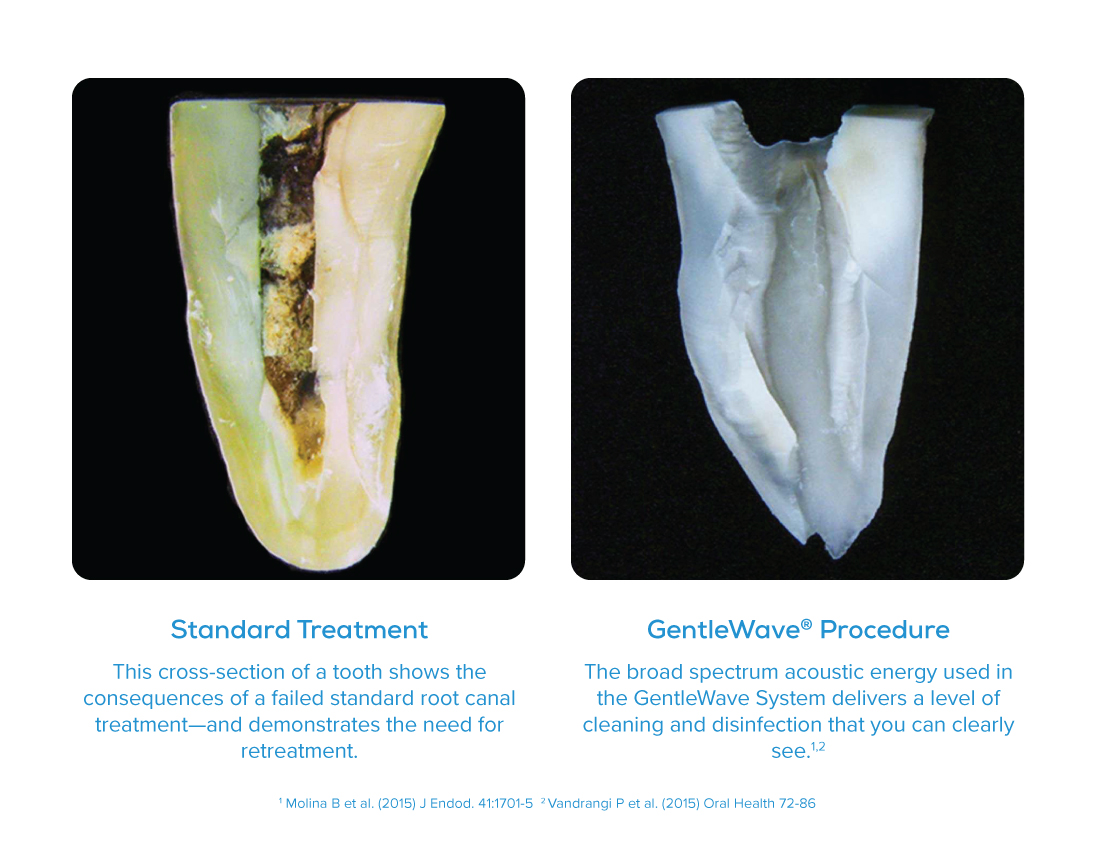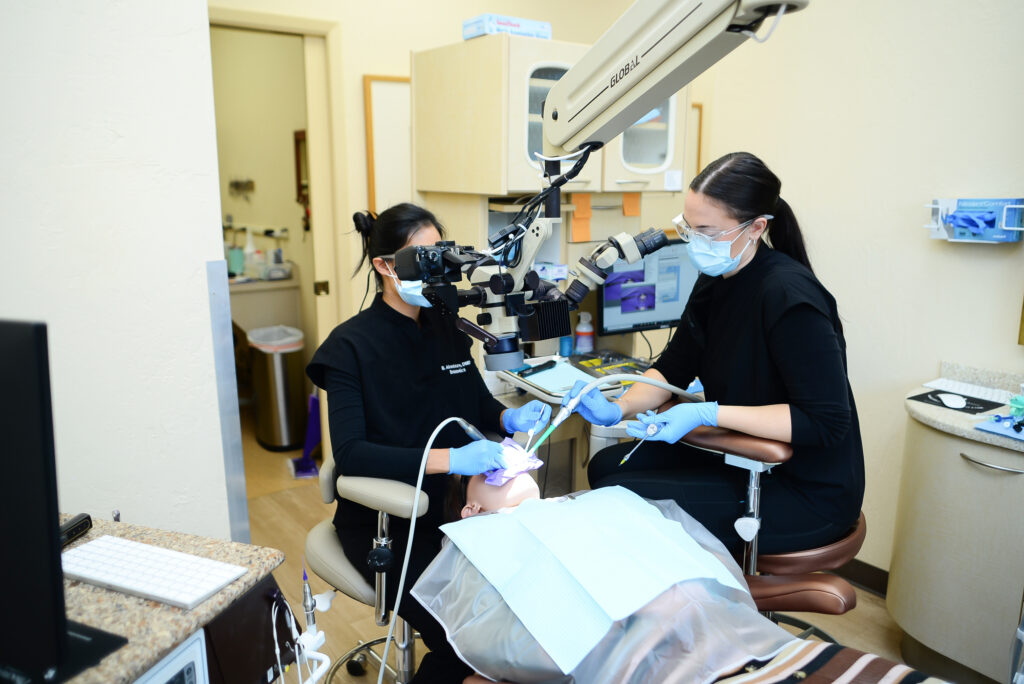
by Dr. Jacqueline S. Allen | Jul 7, 2025 | Blog, Endodontist, GentalWave, Root Canal
Most people are familiar with general dentists, but when a dental issue goes deeper—literally—your dentist might refer you to a specialist called an endodontist. But what exactly does an endodontist do? If you’re experiencing tooth pain, sensitivity, or have been told you need a root canal, understanding the role of an endodontist can help you feel more informed and confident in your care.
What Is an Endodontist?
An endodontist is a dental specialist who focuses on diagnosing and treating problems related to the dental pulp and the tissues surrounding the roots of a tooth.  After completing dental school, endodontists undergo two or more additional years of advanced training specifically in root canal therapy, complex tooth anatomy, and pain management. While all endodontists are dentists, not all dentists are endodontists. General dentists handle routine care like cleanings, fillings, and crowns, while endodontists are experts in saving natural teeth through specialized procedures.
After completing dental school, endodontists undergo two or more additional years of advanced training specifically in root canal therapy, complex tooth anatomy, and pain management. While all endodontists are dentists, not all dentists are endodontists. General dentists handle routine care like cleanings, fillings, and crowns, while endodontists are experts in saving natural teeth through specialized procedures.
What Procedures Do Endodontists Perform?
The most common procedure endodontists perform is root canal therapy. However, their expertise extends beyond that. Here’s a breakdown of services typically offered:
- Root Canal Therapy
This treatment is done to remove infected or inflamed pulp tissue inside a tooth. An endodontist carefully cleans and disinfects the inner canals of the tooth, then fills and seals them to prevent further infection.
- Root Canal Retreatment
If a tooth that has already had a root canal becomes painful or infected again, endodontists can retreat the tooth to give it a second chance.
- Apicoectomy (Root-End Surgery)
Sometimes, inflammation or infection persists even after a root canal. In these cases, endodontists may perform an apicoectomy, which involves removing the tip of the root and sealing it to stop the issue at its source.
- Traumatic Dental Injury Treatment
Endodontists also treat teeth that have been cracked, chipped, or knocked out due to accidents or sports injuries. Their training enables them to preserve teeth that may otherwise be lost.
- GentleWave® Procedure
At Phoenix Endodontic Group, we’re proud to offer the GentleWave® procedure as a modern, minimally invasive alternative to traditional root canal treatment. This advanced technology uses a combination of sound waves and fluid dynamics to deeply clean and disinfect even the most complex root canal systems. Unlike traditional root canal methods that rely on manual files to remove infected tissue, the GentleWave® system reaches microscopic spaces and removes bacteria, debris, and infected tissue more thoroughly. The benefits of the GentleWave® procedure are impressive. It is less invasive, preserving more of your natural tooth structure. Patients typically experience less post-operative discomfort, and because the system provides a more complete cleaning, it often reduces the need for multiple visits. Many treatments can be completed in just one appointment. Additionally, GentleWave® minimizes the risk of reinfection by removing bacteria from hard-to-reach areas that traditional methods might miss. By offering the GentleWave® procedure, Phoenix Endodontic Group ensures our patients receive state-of-the-art care with faster recovery times, enhanced comfort, and highly successful outcomes — making root canal treatment safer, easier, and more effective than ever before.
 When Should You See an Endodontist?
When Should You See an Endodontist?
Your general dentist might refer you to an endodontist for several reasons: you have severe tooth pain or prolonged sensitivity to hot or cold, you’ve experienced dental trauma, you need a root canal or root canal retreatment, your tooth has complex anatomy that requires specialized care, or you want to explore advanced treatment options like GentleWave®. Seeing an endodontist can help you save your natural teeth whenever possible, which is always the best option for your long-term oral health.
Benefits of Seeing an Endodontist
Choosing to see an endodontist comes with many advantages. With focused training, endodontists are highly skilled in diagnosing and treating tooth pain and root issues. Many use cutting-edge tools like digital imaging, microsurgical techniques, and advanced technology like GentleWave® to improve accuracy and comfort. Endodontists can often complete complex procedures in fewer visits than a general dentist. Their precision and training often lead to higher success rates, especially for difficult cases.
Trust Your Smile to a Root Canal Specialist
At Phoenix Endodontic Group, our board-certified endodontists specialize in saving teeth with expert care, precision, and compassion. Whether you’ve been referred by your dentist or are exploring options for persistent tooth pain, we’re here to help. Contact us today to schedule a consultation and take the next step toward restoring your oral health and comfort.

by Dr. Jacqueline S. Allen | Mar 10, 2025 | Dental Emergency, Dentistry, Endodontist
Like any medical emergency, dental emergencies require your quick response. If you have an injured tooth, it’s important that you see an endodontist immediately.
You should call 911 and head to an emergency room if an injured tooth has caused an abscess and you are having trouble breathing or swallowing, or if your jaw is broken. Otherwise, call your endodontist for an emergency appointment. At Phoenix Endodontic Group, we can provide emergency care 24/7, so call as soon as you need us, day or night.
Here is a quick guide to ways an endodontist might repair a tooth injury.

How Endodontists Treat Common Tooth Injuries
- If you come to your endodontist with a chipped or cracked tooth – they may recommend reattaching the tooth part with bonding material, placing a crown on the tooth to protect it from further damage, or performing a root canal if the crack in the tooth caused injury to its nerve.
- If you present with a dislodged or knocked-out tooth – they will want to know how recently the injury occurred. Teeth that have been knocked out of the mouth can sometimes be successfully placed back in the mouth if the patient sees an endodontist within 30 to 60 minutes of the incident. Avoid touching the root surface of the injured tooth and handle it carefully. For dislodged teeth, it may be possible for the endodontist to push the tooth back into place and stabilize it. Dislodged teeth sometimes also require root canal treatment.
- If you come in with a horizontal fracture – they will take images to determine the location of the fracture. A fracture near the tooth’s root may be able to be treated with a stabilizing splint, and possibly a root canal. A fracture across the root closer to the gum line is harder to treat and may result in the tooth having to be extracted.
Following many tooth injuries, your endodontist will recommend an annual check for root resorption, where your body rejects the injured tooth and dissolves the tooth root structure.
Don’t Delay – Call Our Office Immediately About Your Injured Tooth
Never delay treatment of an injured tooth. Call us at 602-242-4745 to make an appointment. Our practice offers emergency treatment options to ensure you can get the right treatment when you need it.

by Dr. Jacqueline S. Allen | Jul 1, 2024 | Endodontics, Endodontist
Diamonds last forever. Dental treatments may not. That does not mean the treatments are not valuable. Potentially complex  treatments, such as root canals, can be effective even if they need to be done a second time.
treatments, such as root canals, can be effective even if they need to be done a second time.
Endodontic retreatment offers another chance to natural teeth previously saved with a root canal. If a tooth treated with a root canal becomes sore or painful, even months or years later, see your endodontist immediately. They can determine if the tooth is a candidate for retreatment.
Here are answers to some frequently asked questions about endodontic retreatments, courtesy of practitioners at Phoenix Endodontic Group.
Answers To Common Endodontic Retreatment Questions
Why does my tooth need endodontic retreatment?
Reasons that your original root canal might fail include complex or very small root canals missed during the first procedure, or a delay in getting a crown restoration after your root canal. It’s also possible your tooth experienced new decay or damage, allowing infection to take hold.
Why perform the root canal procedure again if it has failed?
Here is a parallel: If you broke your arm a second time, you would still want the doctor to set the bone and put it in a cast. Endodontic retreatment, a non-surgical option, is one of three choices you may have; the other two are endodontic surgery (apicoectomy) and extraction.
What happens during endodontic retreatment?
Endodontic retreatment is similar to the original root canal procedure. The endodontist will remove your crown and disassemble any materials added to improve your tooth’s structure, such as a post and core. They will remove the current sealant material, carefully examine your tooth’s roots to locate the problem, and clean the canals with disinfecting fluids. Then, the canals will be resealed and a temporary filling placed. You will again need to have a crown placed to finalize the process.
Are endodontic retreatments usually successful?
Endodontic retreatments have a success rate approaching 90 percent. If your endodontist has concerns a retreatment may not be right for you, they may suggest an apicoectomy. In that surgical procedure, a small incision is made near the tooth root to address the infected tooth canals there.
“When we do an endodontic retreatment, we examine our patient’s tooth carefully to ensure the success of the procedure,” says Dr. Jacqueline S. Allen, who practices at the Phoenix Endodontic Group. “We’re happy to answer all your questions, so you’ll feel at ease during your retreatment.”

by Dr. Jacqueline S. Allen | Feb 6, 2024 | Blog, Endodontist, GentalWave, Root Canal

Like carpenters (or stock brokers), endodontists rely on tools of the trade to do their work. Members of both professions have plenty of tools to help them get the job done. Not all tools are created equal for specific tasks, however. Both a screwdriver and a hammer can be used to pound a nail into a board, but the hammer is the better-suited choice.
When performing root canals, endodontists now have a tool better than the metal files of old for cleaning tooth roots. Practitioners at Phoenix Endodontic Group now turn to the GentleWave system to perform root canals. Here’s a quick look at its advantages over traditional root canal tools.
Why GentleWave Beats Them All
- The GentleWave System is minimally invasive. It uses multisonic wave pressure to move specially formulated fluid through your tooth roots. No scraping.
- GentleWave can clean your root canals more completely than traditional tools. A cascade of bubbles moves like a whirlwind, descending then rising out of the canal. This flushes bacteria and biofilm from the tooth, no matter how complex the canal’s shape.
- Most patients feel little or no pain during a GentleWave root canal. An ongoing clinical trial by dental technology provider Sonendo, Inc., reported that 99.5 percent of enrolled patients experienced no pain during a GentleWave root canal utilizing CleanFlow Technology.
- Root canal treatment time is reduced when GentleFlow is used. Many root canal patients can now receive their treatment in a single session. (The necessary final crown will be placed in a later visit.)
“The GentleWave System has revolutionized how root canals are performed,” says Dr. Jacqueline S. Allen of Phoenix Endodontic Group. “It provides a faster, more complete cleaning of root canals with less discomfort. Because of this, we are confident GentleWave is the best option for most patients’ root canal therapy.”

by Dr. Jacqueline S. Allen | Dec 4, 2023 | Blog, Endodontics, Endodontist, Root Canal

Root canal treatment of a damaged or infected natural tooth can enable it to last a lifetime. However, like most treatments, you as the patient must do your part to ensure your procedure is successful.
Proper root canal treatment aftercare can be divided into things you should do immediately after the procedure, during recovery week, and things you should do over the long run. Let’s take a look at each set of instructions so you’ll be well prepared when you have your root canal treatment.
Aftercare Tips: Immediately After Your Root Canal Treatment
Do not eat for several hours after your root canal. This allows the local anesthesia to wear off – you will avoid biting injuries due to numbness.
Do not smoke after your root canal treatment. Smoking tobacco impedes healing.
Make sure you have antibiotics prescribed by your endodontist. This allows you to continue to fight any infection in your tooth.
Keep the endodontist’s contact information handy in case there is post-procedure pain. You should NOT have excruciating pain after a root canal – if you do, call the office so they can look into what is happening.
Aftercare Tips: The Week After Your Root Canal Treatment
Do not bite down using the tooth that received the root canal. Until you’ve had a permanent restoration (usually a crown) placed, you could lose your temporary filling by putting biting pressure on the tooth.
Stick to soft foods while your mouth is healing. You can choose from delicious options that include scrambled eggs, smoothies, yogurt, pasta, noodle dishes, mashed potatoes, meatloaf, hummus, cooked vegetables, or sorbets.
Ease back into your regular activities. You can go to work in a day or two, and start exercising a few days after that. When in doubt, don’t push things; let your body guide recovery.
Aftercare Tips: When Your Root Canal Treatment Is Finished
Make sure you get the permanent restoration (usually a crown) placed over your root canal. This one step is critical to protecting the root canal and cannot be skipped.
Continue to brush and floss daily. You can care for your tooth that received the root canal as you would any natural tooth after the healing stage is complete.
Visit your general dentist regularly. They will monitor your overall oral health and can refer you to an endodontist if you need another root canal or a root canal retreatment.
“Most of the steps that we ask our patients to take after a root canal treatment are simple, but they should be followed closely,” says Dr. Jacqueline S. Allen, who practices with Phoenix Endodontics Group. “We are happy to discuss how to follow aftercare instructions and why they are important.”

by Dr. Jacqueline S. Allen | Nov 3, 2023 | Blog, Endodontics, Endodontist, Root Canal

When times are tough, folks yearn for the “good old days.” However, most of us wouldn’t really want to travel back in time for complex dental work. For endodontic procedures such as root canal therapy, patient outcomes and happiness have improved immensely, on the heels of improvements in technology and treatment techniques.
Here’s a brief list of just some ways root canal therapy has gotten better over recent generations.
Advancements In Root Canal Therapy
1. Diagnostic imaging, for better treatment. When root canals were first performed, dentists didn’t have even basic imaging technology to guide their work. Today, treatments can be pinpointed with Cone Beam Computed Tomography, allowing endodontists a full 3-D view of your teeth.
2. Local anesthetics allow a comfortable treatment. The earliest root canal treatments happened before the advent of anesthesia. Today’s patients have largely pain-free experiences through local anesthetics. Further, if dental anxiety is an issue, sedation dentistry can provide a gentle solution.
3. Microsurgical tools allow precision canal cleaning and shaping. The first root-canal shaping tool was developed by Edwin Maynard in the mid-1800s, created from a watch spring. Today’s precise tools for cleaning and shaping infected root canals are developed task-specifically, continually refined, and always crafted with your teeth in mind.
4. New cleansing technologies ensure more complete treatment. Top endodontic practices now use the GentleWave Procedure, a root canal treatment that uses fluid dynamics to ensure superior canal cleaning. The result is a faster, less invasive root canal with minimal pain and rapid healing.
5. Restorations ensure root canal treatments remain successful. Early root canal treatments were not followed by the placement of restorations such as a permanent crown. This critical step has hugely enhanced the long-term success rate of root canals, allowing a properly cared for root canal treatment to often last a lifetime.
At Phoenix Endodontic Group, practitioners use all our available advances to provide state-of-the-art treatment.
“When you enter one of our treatment rooms, every aspect of your root canal treatment has been evaluated and selected to provide you with the safest, most comfortable treatment possible. Our goal is preserving your natural teeth, so you can enjoy them for a lifetime,” says Dr. Jacqueline S. Allen, founder of the practice.

 After completing dental school, endodontists undergo two or more additional years of advanced training specifically in root canal therapy, complex tooth anatomy, and pain management. While all endodontists are dentists, not all dentists are endodontists. General dentists handle routine care like cleanings, fillings, and crowns, while endodontists are experts in saving natural teeth through specialized procedures.
After completing dental school, endodontists undergo two or more additional years of advanced training specifically in root canal therapy, complex tooth anatomy, and pain management. While all endodontists are dentists, not all dentists are endodontists. General dentists handle routine care like cleanings, fillings, and crowns, while endodontists are experts in saving natural teeth through specialized procedures. When Should You See an Endodontist?
When Should You See an Endodontist?



 treatments, such as root canals, can be effective even if they need to be done a second time.
treatments, such as root canals, can be effective even if they need to be done a second time.



